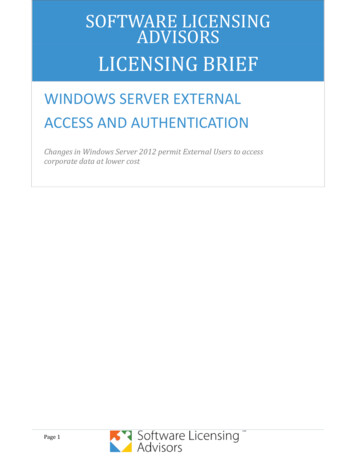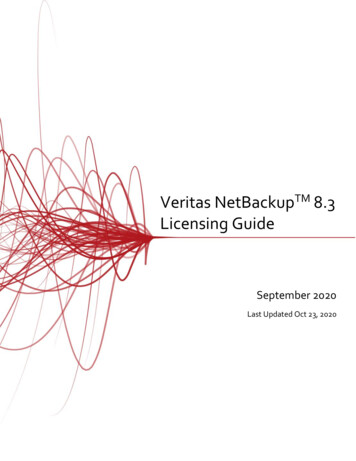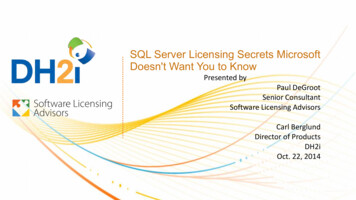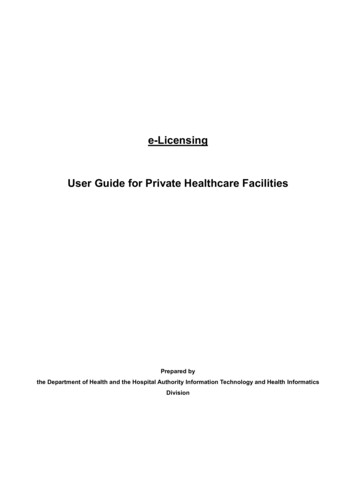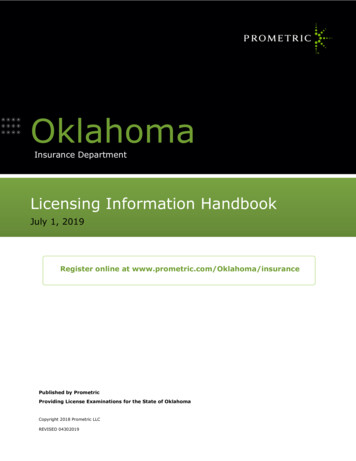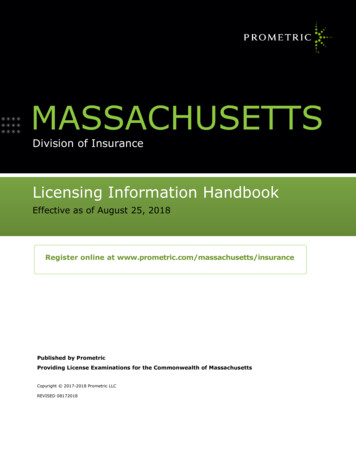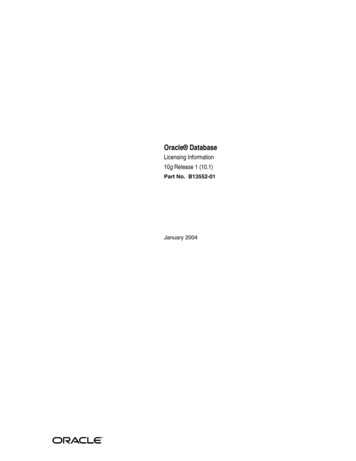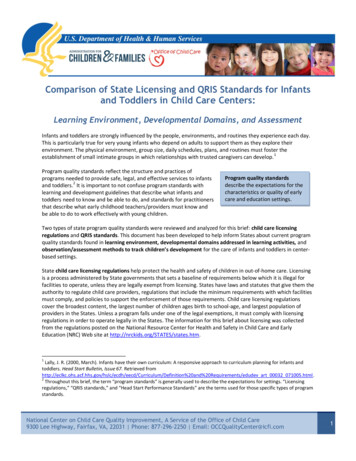
Transcription
The OfficeComparison of State Licensing and QRIS Standards for Infantsand Toddlers in Child Care Centers:Learning Environment, Developmental Domains, and AssessmentInfants and toddlers are strongly influenced by the people, environments, and routines they experience each day.This is particularly true for very young infants who depend on adults to support them as they explore theirenvironment. The physical environment, group size, daily schedules, plans, and routines must foster theestablishment of small intimate groups in which relationships with trusted caregivers can develop. 1Program quality standards reflect the structure and practices ofprograms needed to provide safe, legal, and effective services to infantsand toddlers.2 It is important to not confuse program standards withlearning and development guidelines that describe what infants andtoddlers need to know and be able to do, and standards for practitionersthat describe what early childhood teachers/providers must know andbe able to do to work effectively with young children.Program quality standardsdescribe the expectations for thecharacteristics or quality of earlycare and education settings.Two types of state program quality standards were reviewed and analyzed for this brief: child care licensingregulations and QRIS standards. This document has been developed to help inform States about current programquality standards found in learning environment, developmental domains addressed in learning activities, andobservation/assessment methods to track children’s development for the care of infants and toddlers in centerbased settings.State child care licensing regulations help protect the health and safety of children in out-of-home care. Licensingis a process administered by State governments that sets a baseline of requirements below which it is illegal forfacilities to operate, unless they are legally exempt from licensing. States have laws and statutes that give them theauthority to regulate child care providers, regulations that include the minimum requirements with which facilitiesmust comply, and policies to support the enforcement of those requirements. Child care licensing regulationscover the broadest content, the largest number of children ages birth to school-age, and largest population ofproviders in the States. Unless a program falls under one of the legal exemptions, it must comply with licensingregulations in order to operate legally in the States. The information for this brief about licensing was collectedfrom the regulations posted on the National Resource Center for Health and Safety in Child Care and EarlyEducation (NRC) Web site at http://nrckids.org/STATES/states.htm.1Lally, J. R. (2000, March). Infants have their own curriculum: A responsive approach to curriculum planning for infants andtoddlers. Head Start Bulletin, Issue 67. Retrieved rriculum/Definition%20and%20Requirements/edudev art 00032 071005.html.2Throughout this brief, the term “program standards” is generally used to describe the expectations for settings. “Licensingregulations,” “QRIS standards,” and “Head Start Performance Standards” are the terms used for those specific types of programstandards.National Center on Child Care Quality Improvement, A Service of the Office of Child Care9300 Lee Highway, Fairfax, VA, 22031 Phone: 877-296-2250 Email: OCCQualityCenter@icfi.com1
State Standards About Learning Environment, Developmental Domains, and Assessment (No. 181)March 2014Child Care’s National Child Care Information and Technical Assistance CenterQRIS standards are used to assign ratings to programs that participate in QRIS, which is a systemic approach usedby a growing number of States to assess, improve, and communicate the level of quality in early and school-agecare programs. These standards provide parents and the public with information about each program’s quality.States typically use licensing regulations as the starting point or base of the system, upon which higher levels ofquality standards are built. Currently, 36 States have a statewide QRIS model. There are additional States that havea pilot or field test of a QRIS underway, are engaged in planning to develop a QRIS, or operate multiple local QRISmodels. The information about QRIS standards was compiled from documents found on the States’ Web sites. Thedocument, QRIS Quality Standards Web Sites (2013), by the National Center on Child Care Quality Improvement,has links to all States’ QRIS standards, IS Standards Websites.pdf.Head Start Program Performance Standards are federal regulations that all grantee and delegate agencies mustmaintain in the provision of Head Start services. Within these standards are specific requirements for Early HeadStart programs that serve infants and toddlers, ages birth to three years. Throughout this brief, there are blue textboxes with summaries of the requirements for Early Head Start programs in these content areas. The Head StartProgram Performance Standards are available %20Start%20Requirements.Learning Environment for Infants and ToddlersThe learning environment standards in licensing and QRIS differ. In general, licensing regulations require that childcare centers have daily planned activities and support infant’s exploration of the environment, while QRISgenerally rely on the Infant-Toddler Environment RatingEarly Head Start programs must encourage theScale (ITERS) as a measure.3 QRIS standards build on thedevelopment of secure relationships in out-offoundation of licensing, so States with a QRIS rely onhome care settings for infants and toddlers bylicensing to cover some aspects of providing a supportivehaving a limited number of consistent teachersenvironment for infant and toddler development and do notover an extended period of timeinclude those specific requirements in their QRIS standards.[1304.21(b)(1)(i)].As shown in Table 1, about half of the States require aprimary caregiver for infants and toddlers in their licensingrequirements. Research has shown that limiting the numberof adults with whom an infant interacts fosters reciprocalunderstanding of communication cues that are unique toeach child. This leads to a sense of trust of the adult by theinfant that the infant’s needs will be understood and met4promptly.(§ 1304.21 Education and early childhooddevelopment is available ation about environment ratings scales is available from the Frank Porter Graham Child Development Institute athttp://ers.fpg.unc.edu/.4Cassidy J., Shaver, P., eds. 1999. Handbook of attachment: Theory, research and clinical applications, 671-87. 2nd ed. NewYork: Guilford Press.National Center on Child Care Quality Improvement, A Service of the Office of Child Care9300 Lee Highway, Fairfax, VA, 22031 Phone: 877-296-2250 Email: OCCQualityCenter@icfi.com2
March 2014State Standards About Learning Environment, Developmental Domains, and Assessment (No. 181)Child Care’s National Child Care Information and Technical Assistance CenterTable 1: Learning Environment Standards for Infants and ToddlersNumber of States withStandardsProgram Standards for Infants and ToddlersLicensingQRIS(N 50)(N 36)Primary caregiver for each infant and toddler241Written plan of daily learning activities for infants and toddlers3610Actively encourage and support infants’ exploration of the environment144Use ITERS to assess the learning environment028N Number of States with statewide standards, and includes the District of Columbia. Idaho does not have statewide licensing requirements,so it is excluded from those data. Arizona, the District of Columbia, and Kansas have QRIS, but their full standards are not available online, sothey are excluded from the data except for cases when there was data available from previous research.See the Appendix for Table A: Learning Environment Standards in Each State that shows which set of programquality standards—child care licensing or QRIS—contain the specific content for each State.Developmental Domains Addressed in Learning ActivitiesState licensing regulations often include requirements that learning activities align with the domains of childdevelopment, such as social, physical, cognitive, emotional, language/literacy, and cultural development. Table 2shows that almost three-quarters of States address multiple developmental domains in child care licensingrequirements.Early Head Start programs are required to:Support the social and emotional development of infants and toddlers by promoting an environment that:(i) Encourages the development of self-awareness, autonomy, and self-expression; and(ii) Supports the emerging communication skills of infants and toddlers by providing daily opportunities foreach child to interact with others and to express himself or herself freely. [1304.21(b)(2)]Promote the physical development of infants and toddlers by:(i) Supporting the development of the physical skills of infants and toddlers including gross motor skills, suchas grasping, pulling, pushing, crawling, walking, and climbing; and(ii) Creating opportunities for fine motor development that encourage the control and coordination of small,specialized motions, using the eyes, mouth, hands, and feet. [1304.21(b)(3)](§ 1304.21 Education and early childhood development is available l Center on Child Care Quality Improvement, A Service of the Office of Child Care9300 Lee Highway, Fairfax, VA, 22031 Phone: 877-296-2250 Email: OCCQualityCenter@icfi.com3
March 2014State Standards About Learning Environment, Developmental Domains, and Assessment (No. 181)Child Care’s National Child Care Information and Technical Assistance CenterThe way State QRIS standards address child development in learning activities is a bit different. About half of thestate QRIS include a specific alignment with the states’ infant-toddler learning and development guidelines (ELGs).5Through this alignment programs are expected to develop their curriculum and learning activities based on theELGs. There is one State QRIS (Texas) that does not have alignment with ELGs but does have standards thatprograms must address developmental domains in their learning activities. It should be noted that most of theStates with QRIS standards that do not have alignment with ELGs use the ITERS, which includes subscales thataddress in some capacity the developmental domains mentioned above .Table 2: Developmental Domains Addressed in Learning Activities/Curriculum for Infants and ToddlersNumber of States withStandardsProgram Standards for Infants and ToddlersLicensingQRIS(N 50)(N 36)Alignment with infant/toddler learning and development guidelines (e.g., learningactivities are based on ELGs)217Address multiple developmental domains in the learning activities for infants andtoddlers3617* Social development3318 Emotional development3118 Physical development (i.e., gross motor and fine motor)3618 Cognitive development3018 Language development (i.e., communication with infants/toddlers)2918 Cultural development (e.g., providers need to understand the child’s familyculture and/or speak the child’s language)1813N Number of States with statewide standards, and includes the District of Columbia. Idaho does not have statewide licensing requirements,so it is excluded from those data. Arizona, the District of Columbia, and Kansas have QRIS, but their full standards are not available online, sothey are excluded from the data except for cases when there was data available from previous research.*Developmental domains are addressed in QRIS through alignment with the early learning and development standards.See the Appendix for Table B: Developmental Domains Addressed in Standards in Each State that shows which setof program quality standards—child care licensing or QRIS—contain the specific content for each State.5Links to each State’s early learning guidelines is available in the document, State/Territory Early Learning Guidelines (2011), bythe National Center on Child Care Quality Improvement les/075 1301 state elgs web 0.pdf.National Center on Child Care Quality Improvement, A Service of the Office of Child Care9300 Lee Highway, Fairfax, VA, 22031 Phone: 877-296-2250 Email: OCCQualityCenter@icfi.com4
March 2014State Standards About Learning Environment, Developmental Domains, and Assessment (No. 181)Child Care’s National Child Care Information and Technical Assistance CenterObservation and Assessment of ChildrenChild assessment includes activities (observations, portfoliodevelopment, and appraisal of performance using multipleindicators) that measure and track a child’s learning anddevelopment. At the program level, the results informclassroom practice, curriculum development, and learningactivities. Results are typically shared with parents and arealso used to address the needs of individual children.Early Head Start programs are required tocollect information on each child's functioningin these areas: gross and fine motor skills,perceptual discrimination, cognition, attentionskills, self-help, social and receptive skills andexpressive language. [1308.6(d)](§1308.6 Assessment of children is available atVery few States include the observation and assessment %children in licensing requirements; however, most of es with a QRIS have standards regarding childessment%20of%20children.htm)assessment. Instead of requiring specific assessment tools,the QRIS tend to have criteria related to observing and documenting children’s development and using the resultsto inform families and improve practice. Table 3 provides the number of States with standards about observationand/or assessment in their standards.Table 3: Observation and Assessment of ChildrenNumber of States withStandardsProgram Standards for Infants and ToddlersLicensingQRIS(N 50)(N 36)Use observation and/or assessment methods to document children’s development425Share assessment results with families420Use assessment results to individualize curriculum or improve practice419N Number of States with statewide standards, and includes the District of Columbia. Idaho does not have statewide licensing requirements,so it is excluded from those data. Arizona, the District of Columbia, and Kansas have QRIS, but their full standards are not available online, sothey are excluded from the data except for cases when there was data available from previous research.See the Appendix for Table C: Observation and Assessment Standards in Each State that shows which set ofprogram quality standards—child care licensing or QRIS—contain the specific content for each State.National Center on Child Care Quality Improvement, A Service of the Office of Child Care9300 Lee Highway, Fairfax, VA, 22031 Phone: 877-296-2250 Email: OCCQualityCenter@icfi.com5
State Standards About Learning Environment, Developmental Domains, and Assessment (No. 181)March 2014Child Care’s National Child Care Information and Technical Assistance CenterAppendixThe following tables show the which set of program quality standards—child care licensing or QRIS—contain thespecific content for each State.Table ATable A: Learning Environment Standards in Each StatePrimary CaregiverLearning ActivitiesPlanInfants’ Exploration ingSTATEARLicensingQRIS1,2ITERS Used toAssess RISNational Center on Child Care Quality Improvement, A Service of the Office of Child Care9300 Lee Highway, Fairfax, VA, 22031 Phone: 877-296-2250 Email: OCCQualityCenter@icfi.comQRISQRIS6
State Standards About Learning Environment, Developmental Domains, and Assessment (No. 181)March 2014Child Care’s National Child Care Information and Technical Assistance CenterTable A: Learning Environment Standards in Each StateSTATEPrimary CaregiverLicensingMAMDQRISLicensingMEMIInfants’ Exploration ofEnvironmentITERS Used toAssess RISLicensingMNMOLearning ngLicensingQRISQRISQRISQRISLicensingNational Center on Child Care Quality Improvement, A Service of the Office of Child Care9300 Lee Highway, Fairfax, VA, 22031 Phone: 877-296-2250 Email: OCCQualityCenter@icfi.com7
State Standards About Learning Environment, Developmental Domains, and Assessment (No. 181)March 2014Child Care’s National Child Care Information and Technical Assistance CenterTable A: Learning Environment Standards in Each StatePrimary CaregiverLearning LicensingQRISInfants’ Exploration ofEnvironmentITERS Used toAssess WVLicensingLicensingWYNotes:1Licensing standards are different for infants than for toddlers.2Arizona, the District of Columbia, and Kansas have QRIS, but their full standards are not available online, so they are excludedfrom the data except for cases when there was data available from previous research.National Center on Child Care Quality Improvement, A Service of the Office of Child Care9300 Lee Highway, Fairfax, VA, 22031 Phone: 877-296-2250 Email: OCCQualityCenter@icfi.com8
March 2014State Standards About Learning Environment, Developmental Domains, and Assessment (No. 181)Child Care’s National Child Care Information and Technical Assistance CenterTable BTable B: Developmental Domains Addressed in Standards in Each StateSTATEAlignmentwith ELGsforInfants &ToddlersAKDevelopmental Domains Addressed in Learning Activities for Infantsand ingLicensingLicensingNational Center on Child Care Quality Improvement, A Service of the Office of Child Care9300 Lee Highway, Fairfax, VA, 22031 Phone: 877-296-2250 Email: OCCQualityCenter@icfi.com9
March 2014State Standards About Learning Environment, Developmental Domains, and Assessment (No. 181)Child Care’s National Child Care Information and Technical Assistance CenterTable B: Developmental Domains Addressed in Standards in Each StateSTATEAlignmentwith ELGsforInfants &ToddlersMDQRISMEQRISMIMNQRISDevelopmental Domains Addressed in Learning Activities for Infantsand icensingLicensingQRISQRISNational Center on Child Care Quality Improvement, A Service of the Office of Child Care9300 Lee Highway, Fairfax, VA, 22031 Phone: 877-296-2250 Email: OCCQualityCenter@icfi.comLicensingQRIS10
March 2014State Standards About Learning Environment, Developmental Domains, and Assessment (No. 181)Child Care’s National Child Care Information and Technical Assistance CenterTable B: Developmental Domains Addressed in Standards in Each StateAlignmentwith ELGsforInfants &ToddlersDevelopmental Domains Addressed in Learning Activities for Infantsand WYNotes:1Licensing standards are different for infants than for toddlers.2Arizona, the District of Columbia, and Kansas have QRIS, but their full standards are not available online, so they are excludedfrom the data except for cases when there was data available from previous research.National Center on Child Care Quality Improvement, A Service of the Office of Child Care9300 Lee Highway, Fairfax, VA, 22031 Phone: 877-296-2250 Email: OCCQualityCenter@icfi.com11
State Standards About Learning Environment, Developmental Domains, and Assessment (No. 181)March 2014Child Care’s National Child Care Information and Technical Assistance CenterTable CTable C: Observation and Assessment Standards in Each StateSTATEChild Observation orAssessment MethodsAssessment Results Sharedwith FamiliesAssessment Results Used forCurriculum and QRISQRISKS1KYLAMOMSMTNCNational Center on Child Care Quality Improvement, A Service of the Office of Child Care9300 Lee Highway, Fairfax, VA, 22031 Phone: 877-296-2250 Email: OCCQualityCenter@icfi.com12
State Standards About Learning Environment, Developmental Domains, and Assessment (No. 181)March 2014Child Care’s National Child Care Information and Technical Assistance CenterTable C: Observation and Assessment Standards in Each StateChild Observation orAssessment MethodsAssessment Results Sharedwith FamiliesAssessment Results Used forCurriculum and DNENHNJORSCSDTNTXUTVAWVWYNotes:1Arizona, the District of Columbia, and Kansas have QRIS, but their full standards are not available online, so they are excludedfrom the data except for cases when there was data available from previous research.National Center on Child Care Quality Improvement, A Service of the Office of Child Care9300 Lee Highway, Fairfax, VA, 22031 Phone: 877-296-2250 Email: OCCQualityCenter@icfi.com13
State licensing regulations often include requirements that learning activities align with the domains of child development, such as social, physical, cognitive, emotional, language/literacy, and cultural development. Table 2 shows that almost three-quarters of States address multiple developmental domains in child care licensing requirements.
